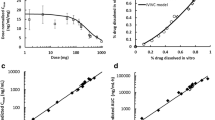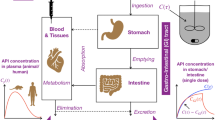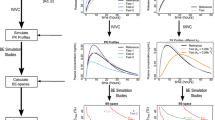Abstract
In vitro-in vivo correlations (IVIVC) are methods used to create a link between biopharmaceutical properties such as dissolution and physiological response such as plasma concentration. Level A IVIVC defines 1:1 relationship between the percent absorbed in vivo and the percent dissolved in vitro. A successful level A IVIVC provides the capacity to predict in vivo behavior based only on in vitro data with application in formulation development and support of biowaivers recognized by regulatory agencies across the world. Level A regression may be complicated due to differences in time scales as well as the lack of coincident times of similar release in vitro and in vivo leading to approximate time-to-time links and subsequent loss of information. Here, a novel method to establish Levy’s plot and to provide time scaling for improved IVIVC predictive capacity is presented. The method is mathematically closed and is an inverse release function (IRF) characterizing the single (or more) phases of dissolution/absorption. It uses the complete set of information available from all time points both in vitro and in vivo. An extended-release formulation development situation is presented with three increasing release rate test products compared in a trial versus a reference product. First, the standard level A regression was made. Prediction errors for internal validation were higher than 10% for Cmax. The IRF method was applied to obtain the in vitro times of percentage dissolved equivalent to percentage absorbed. The prediction errors from the IRF level A correlation were nearly negligible.






Similar content being viewed by others
References
Guidance for industry extended release oral dosage forms: development, evaluation, and application of in vitro/in vivo correlations. FDA CDER September 1997a. Available at: https://www.fda.gov/downloads/drugs/guidances/ucm070239.pdf
Guideline on the pharmacokinetic and clinical evaluation of modified release dosage forms (EMA/CPMP/EWP/280/96 Corr1). CHMP November 2014a (replacing Guideline on Modified Release Oral and Transdermal Dosage Forms Section II (Pharmacokinetic and Clinical Evaluation (EMA/CPMP/EWP/280/96 Corr1)). Available at: http://www.ema.europa.eu/docs/en_GB/document_library/Scientific_guideline/2014/11/WC500177884.pdf.
Guidance for Industry SUPAC-MR: modified release solid oral dosage forms. FDA CDER September 1997b. Available at: https://www.fda.gov/downloads/Drugs/Guidances/ucm070640.pdf.
Guideline on quality of oral modified release products. CHMP March 2014b. Available at: http://www.ema.europa.eu/docs/en_GB/document_library/Scientific_guideline/2014/07/WC500170465.pdf
Roudier B, Davit B, Schütz H, Cardot JM. Impact of data base structure in a successful in vitro-in vivo correlation for pharmaceutical products. AAPS J. 2015;17(1):24–34. https://doi.org/10.1208/s12248-014-9680-x.
Suarez-Sharp S, Li M, Duan J, Shah H, Seo P. Regulatory experience with in vivo in vitro correlations (IVIVC) in new drug applications. AAPS J. 2016;18(6):1379–90. https://doi.org/10.1208/s12248-016-9966-2.
Cardot J-M, Davit BM. In vitro–in vivo correlations: tricks and traps. AAPS J. 2012;14(3):491–9. https://doi.org/10.1208/s12248-012-9359-0.
Emami J. In vitro-in vivo correlation: from theory to application. J Pharm Pharmaceut Sci. 2006;9(2):169–89.
Levy G, Leonards JR, Procknal JA. Interpretation of in vitro dissolution data relative to the gastrointestinal absorption characteristics of drugs in tablets. J Pharm Sci. 1967;56(10):1365–7.
Hemmingsen PH, Haahr AM, Gunnergaard C, Cardot JM. Development of a new type of prolonged release hydrocodone formulation based on Egalet® ADPREM technology using in vivo-in vitro correlation. Pharmaceutics. 2011;3(1):73–87. https://doi.org/10.3390/pharmaceutics3010073.
Marvola J, Kanerva H, Slot L, Lipponen M, Kekki T, Hietanen H, et al. Neutron activation-based gamma scintigraphy in pharmacoscintigraphic evaluation of an Egalet constant-release drug delivery system. Int J Pharm. 2004;281(1–2):3–10. https://doi.org/10.1016/j.ijpharm.2004.05.022.
D'Souza SS, Faraj JA, DeLuca PP. A model-dependent approach to correlate accelerated with real-time release from biodegradable microspheres. AAPS PharmSciTech. 2005;6(4):E553–64. https://doi.org/10.1208/pt060470.
González-García I, Mangas-Sanjuan V, Merino-Sanjuán M, Álvarez-Álvarez C, Díaz-Garzón Marco J, Rodríguez-Bonnín MA, et al. IVIVC approach based on carbamazepine bioequivalence studies combination. Pharmazie. 2017;72(8):449–55. https://doi.org/10.1691/ph.2017.7011.
Ruiz Picazo A, Martinez-Martinez MT, Colón-Useche S, Iriarte R, Sánchez-Dengra B, González-Álvarez M, et al. In vitro dissolution as a tool for formulation selection: telmisartan two-step IVIVC. Mol Pharm. 2018;15(6):2307–15. https://doi.org/10.1021/acs.molpharmaceut.8b00153.
Otsuka K, Wagner C, Selen A, Dressman J. Prediction of in-vivo pharmacokinetic profile for immediate and modified release oral dosage forms of furosemide using an in-vitro-in-silico-in-vivo approach. J Pharm Pharmacol. 2015;67(5):651–65. https://doi.org/10.1111/jphp.12365.
Acknowledgements
We thank Egalet (Egalet Denmark, Lejrvej 37-41, DK-3500 Værløse, Denmark) for providing the dataset with permission by the authors (Ref. No. 10).
Author information
Authors and Affiliations
Corresponding author
Rights and permissions
About this article
Cite this article
Cardot, J.M., Lukas, J.C. & Muniz, P. Time Scaling for In Vitro-In Vivo Correlation: the Inverse Release Function (IRF) Approach. AAPS J 20, 95 (2018). https://doi.org/10.1208/s12248-018-0250-5
Received:
Accepted:
Published:
DOI: https://doi.org/10.1208/s12248-018-0250-5




